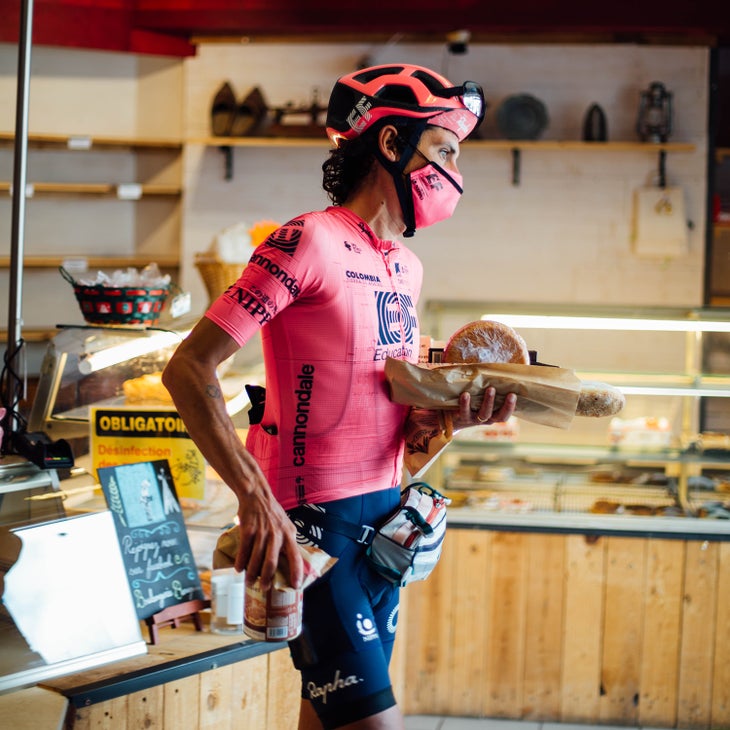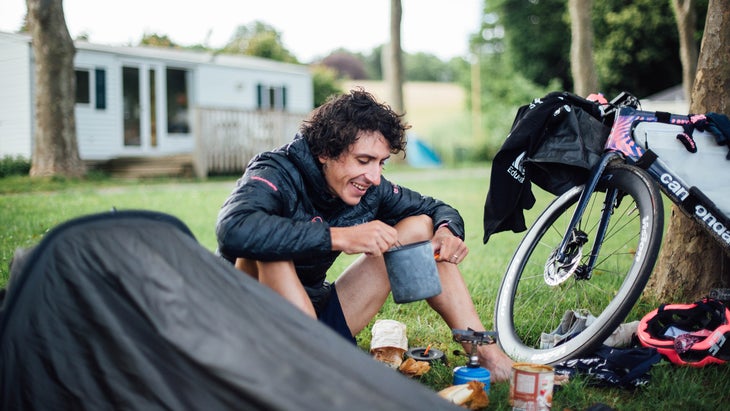Meet Lachlan Morton, The Man Who Rode the Tour de France Route Solo
This dude is a legend. What an incredible feat of endurance cycling. My favorite story of the year.
Early Tuesday morning, Lachlan Morton, the 29-year-old pro cyclist for the WorldTour race team EF Education-Nippo, entered Paris and rode the eight laps of the Champs-Elysées that signify the end of the Tour de France. He was the first rider to cross the finish line of this years race. But wait, you say: the Tour is still back in the Pyrenees, hundreds of miles to the south, and has five stages yet to race. How can Morton have already won?
Let’s back up. Just over two weeks ago, Morton set off from the Grand Depart in Brest an hour after the 184 official starters. The odd start time was because he’s not actually in the Tour. His ride, which he called the Alt Tour, was an homage to its first editions more than a century ago. It blended the rules and spirit of the inaugural 1903 race, which prized riders’ self-reliance, with the modern adventure riding trend of bikepacking.
He carried all his own gear, made all his own repairs, and prepared his own food. He camped en route. And in a twist that those who know Morton say is perfect for him, he did not just ride the 2,082 miles of the race’s 21-stage route. He rode the transfers between the stages too, which added roughly 1,300 more miles to his tally for a total of 3,424.

The last transfer was a monster: almost 350 miles with more than 14,000 feet of elevation gain, in a near straight line north from Bordeaux. Morton being Morton, he wanted to do it in a single push, without stopping. He started that final push on Monday morning, just outside Bordeaux, and even as he drew closer to Paris, his journey had never been harder. “I wanted to do one stage that’s as long as the longest Tour stage ever,” he says of the 294-mile Stage 5 from the 1919 edition. “I want to get a feel for what that would’ve been like.”
The inspiration for Morton’s unlikely rep came about late last summer. He was on the start list for October’s Giro d’Italia. The team’s general manager Jonathan Vaughters had an idle conversation with Philip Hult, the chairman of the education company that now owns the team. As Vaughters recalls, Hult said something along the lines of, “wouldn’t it be funny if Lachlan tried to race the peloton, but had to ride all by himself, and like, swim the Strait of Messina with his bike on his back?”
It wasn’t a joke Hult would make about most of the riders on his team, but Morton is not most racers. A pro cyclist and gifted climber, he won the 2016 Tour of Utah, but he’s perhaps even better known for endurance feats like setting two Everesting records in a single week. In 2014, he and his brother Gus, a former pro racer, rode 2,500 kilometers self-supported from their birthplace of Port Macquarie, Australia, to Uluru, the sacred sandstone monolith in the center of the country. The documentary Gus made about their trip, called “Thereabouts,” was a hit in the cycling world, capturing the spirit of the nascent gravel-riding and bikepacking movements, alternative forms of the sport that were on the rise.
Hult’s musing was too late for the 2020 Giro but, later that year, he brought it up again, in context of the 2021 Tour. Vaughters and Morton looked into it, poring over the route details separately. Finally, Vaughters asked Morton for an answer. “I think I can do it,” came the reply.
“This is a true Tour of France,” Morton says.
The three-week Tour (the official one) is arguably the hardest endurance event on the planet. To give you an idea of the strain, Ben O’Connor, currently in fifth place overall, posted a Strava file for Stage 15 that listed more than 6,600 kiloJoules of work. That energy burn is roughly five times his resting metabolic rate, which is higher than most mammals and not far off migratory birds. But outside of that, everything is taken care of for racers: they sleep in hotels and ride team buses to and from starts and finishes. While mechanics obsessively clean, repair, and tune their bicycles every night, riders get daily massages and chef-prepared meals designed for optimal fueling and recovery.
In some ways, the original Tour was easier. Back then, riders could still race for stage wins (but not the overall title) even if they didn’t finish the previous one, so they would use trains to catch up. And the race was much flatter than today’s courses. Lachlan’s route had more than 200,000 feet of elevation gain—significantly more than the original Tour, which didn’t even enter the Pyrenees until its seventh edition, in 1910. When it did, one of the riders, Octave Lapize, called the organizers “assassins” for sending them over the steep, unpaved cols.
In other respects, the early Tours were much harder. The race was designed to be so difficult, Vaughters notes, that only one rider would finish. While it had fewer stages, they were routinely 200 miles long or more, and the total distance exceeded 3,000 miles for most of the 1910s and 1920s. Riders had to carry their own spare tires and other equipment; there were no team cars following the race. And while derailleurs were invented in the early 1900s, they weren’t allowed in the Tour until 1937.
Morton wanted to reconnect with those roots. Minus the train rides and the lack of derailleurs. He did the route solo because, Vaughters says, “he’s the only person on the team we felt could actually do it.” In fact, he may have been the only person in the entire pro road peloton with the ability to do it. He has thousands of miles of adventure riding experience, and the mental and emotional resilience that goes along with it. And he was willing to sacrifice race-ready form for ultra-endurance. His training was optimized around weeks of spending at least 12 hours a day in the saddle. “He has almost no fast-twitch muscle fiber left,” says Vaughters.
Morton had to do all of his own bike maintenance and repair, prepare his own food, and carry his own gear (almost 30 pounds of it, not including his Cannondale SuperSix race bike). He fixed his own flat tires—seven of them as of Sunday, when he answered a few questions for Outside—and when his last spare inner tube punctured, he used the repair kit from his sleeping pad to patch it until he could buy a replacement tube. He slept outside, on the ground.

All of that was his idea, as was riding the transfers. When you drive and stay in hotels, he says, “you miss out on a lot of interaction with people. You have a patchwork idea of what the country is, as opposed to a contiguous changing of the map.”
Logistically, bikepacking is also easier than trying to arrange your schedule by hotels. Morton’s day usually started around sunrise, when he broke camp, had breakfast (sometimes just cold coffee), and started riding. He’d stop at cafés for food, following his GPS waypoints and knowledge of the route. Sometimes he rode at night by headlamp. Most of the time he’d get as far as he could during the day—usually close to 200 miles at a shot—and then start scanning his surroundings near dusk for good campsites, where he’d eat simple food like beans and bread. But even more than Tour riders, he couldn’t get enough calories, and his body slowly started cannibalizing itself, says Vaughters. The good days were when he treated himself to a restaurant dinner, maybe a few glasses of wine, just like Tour racers of old.
But his big transfer push to Paris was not a good day. His bike’s bottom bracket was squeaking and grinding with every pedal stroke. His knee was aching again, as it had for weeks. Just five days into the Alt Tour, it was bothering him so much that he switched from cycling shoes and clipless pedals to Birkenstock sandals and flat pedals.
But somehow, in the final stretch to Paris, when he should have been breaking down, he was accelerating. He rode all Monday and then into the night, far from the race route—the Tour racers do this final transfer by plane—so there were none of the familiar, comforting yellow route arrows. On the race route, “it’s like Christmas,” he says. “People are super friendly in the towns where the race is coming. They’ll cheer any bike rider coming through.” Now, on the transfer, that felt like a lifetime ago.
What kept him going? Maybe his fundraiser for World Bicycle Relief, a charity that provides bicycles and entrepreneurial training in developing countries. His project has raised almost $475,000, enough for more than 3,200 bicycle donations. Maybe it was the documentary film project he’s been making on his odyssey. Or maybe it was that his ride has been a fantastic PR success for his team, with media coverage by NBC Sports, the Guardian, and the Wall Street Journal, among others. Vaughters estimates that media coverage and fan engagement for Morton’s ride has been double what the team has generated in the official Tour, even though its star rider, Rigoberto Uran, is in second overall.
Vaughters theorizes that fans have responded so strongly because Morton’s effort is a throwback to the old Tours in more ways than one. “Cycling was historically a sport of storytelling,” he says. “It’s man against himself; man against nature.” Made-for-TV modern road racing is many things, but it’s not that.
But maybe what kept Morton going the most is that this is what he’s meant to do. After the success of “Thereabouts,” Morton’s brother Gus co-founded a film production studio by the same name. More adventure film projects followed, and in them, Morton found his place in bike racing, a liminal space between being a WorldTour pro and a world adventurer. He needs both, Vaughters thinks. And the Alt Tour has been so successful they’re already talking about making more plans.
After almost 17 days of riding, including the last 24 hours straight, Morton could have stopped after his long transfer ride and taken a rest before tackling the final stage. But, he says, he wasn’t looking forward to riding in Paris’ city traffic, without the benefit of road closures like the Tour peloton. So as he neared the start line for Stage 21, he just kept riding. Through the outskirts of the sleeping city, to its heart, to those eight finishing laps so familiar to cycling fans—up and down the Champs, the loops around the Arc de Triomphe and the Jardin des Tuileries—he pushed on.
The sky was just brightening in the east as he crossed a finish line no one else ever has. He popped a bottle of champagne to spray supporters who’d come out to cheer him on, just like a pro on a podium. What next? A nap, probably. Then he’s going to buy some new clothes, he says, and some shoes to replace the trashed Birkies. “I want to go down to Luxembourg Gardens, and just sit down and eat a sandwich,” he says. And then Lachlan Morton is going to keep on riding.
article source: https://www.outsideonline.com/outdoor-adventure/biking/lachlan-morton-tour-de-france-route-solo-alt-tour/